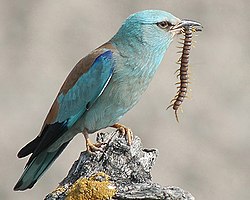Top Qs
Timeline
Chat
Perspective
Coracias
Genus of birds From Wikipedia, the free encyclopedia
Remove ads
Coracias is a genus of the rollers, an Old World family of birds related to the kingfishers and bee-eaters. They share the colourful appearance of those groups, blues and browns predominating. The two outer front toes are connected, but not the inner one.
Remove ads
Taxonomy
Summarize
Perspective
The genus Coracias was introduced in 1758 by the Swedish naturalist Carl Linnaeus in the tenth edition of his Systema Naturae.[1] The genus name is from Ancient Greek korakías (κορακίας),[2] derived from korax (κόραξ, ‘raven, crow’).[3] Aristotle described the coracias as a bird as big as a crow with a red beak,[4] which some believe to be the chough.[5] The type species was designated as the European roller (Coracias garrulus) by George Robert Gray in 1855.[6][7]
The phylogenetic relationships among the Coracias species are shown below, from the molecular study by Johansson et al. (2018)[8]
| Coracias |
| ||||||||||||||||||||||||||||||||||||||||||||||||
Species
Nine species are recognized:[9]
Former species
Formerly, some authorities also considered the following species (or subspecies) as species within the genus Coracias:
- Olive-backed oriole (as Coracias sagittata)[10]
- Eurasian golden oriole (as Coracias oriolus)[11]
- Black-hooded oriole (as Coracias xanthornus)[12]
- Broad-billed roller (as Coracias glaucurus)[13]
- Broad-billed roller (afer) (as Coracias afra)[14]
- Oriental dollarbird (as Coracias orientalis)[15]
- Australian roller (as Coracias pacifica)[16]
Remove ads
Behaviour and ecology
Coracias rollers are watch-and wait hunters. They sit in a tree or on a post before descending on their prey and carrying it back in the beak to a perch before dismembering it. A wide range of terrestrial invertebrates, and small vertebrates such as frogs, lizards rodents and young birds, are taken. Their prey includes items avoided by many other birds, such as hairy caterpillars, insects with warning colouration and snakes.[17] They often perch prominently whilst hunting, like giant shrikes.
Remove ads
References
External links
Wikiwand - on
Seamless Wikipedia browsing. On steroids.
Remove ads



















